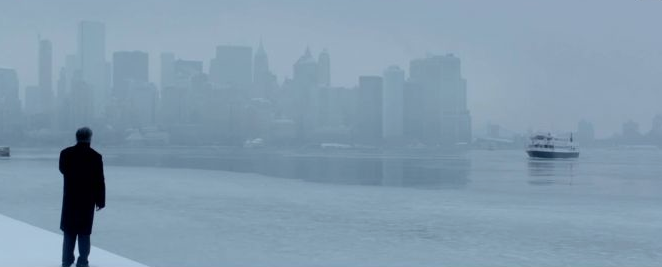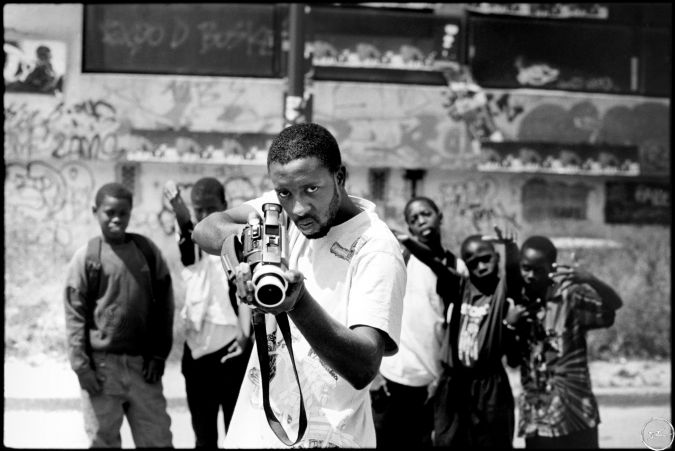By providing your information, you agree to our Terms of Use and our Privacy Policy. We use vendors that may also process your information to help provide our services. This site is protected by reCAPTCHA Enterprise and the Google Privacy Policy and Terms of Service apply.
Anonymous French Artist JR on Why Sponsors Ruin Art and His New Robert De Niro-Starring Short Film
Sonya Saepoff

 READ MORE: What’s In Store at The ‘New Yorker Festival’
READ MORE: What’s In Store at The ‘New Yorker Festival’
If you’ve seen arial shots of giant pictures of people’s faces, then you’ve probably seen the work of JR, the French artist behind the giant black-and-white images of ordinary people displayed on buildings in many countries throughout the world. At the New Yorker Festival over the weekend, JR had a conversation with the magazine’s art editor, Francoise Mouly. In addition, he premiered his new short film,”Ellis,” written by Eric Roth and starring Robert De Niro. Check out the highlights from the discussion below.
JR reveals that his art started as street graffiti
During the post-screening discussion, JR talked about how when he was a teenager he liked to climb on the rooftops of Paris. “There is something human about wanting to explore and climb around,” he shared, “and climbing on the rooftops always gave me a better view of the city. My artistic career first started when I began doing street graffiti; I went from just putting my initials everywhere to creating actual street art. I then decided I wanted to be part of documenting what was happening on the streets. My first exhibition was on the streets of Paris on the Champs Élysée.”
“I spray painted frames around the pictures I took and put them on the walls. I received advice to just go out at rush hour and to take my time when putting up my street art on the Champs Élysée. People would walk around me and not notice or seem to care — even the police didn’t notice me. I would do street art all over Paris, as well as in the suburbs. Once, I went to my friend’s neighborhood and I was shocked at how abandoned it was because the train didn’t reach that neighborhood. I took a photo in this neighborhood and it became one of my signature photos.”

JR began shooting in black and white to save money
“I began with black and white photos because the printing cost was less expensive; then I continued with it because I liked the look of it. When there were riots in this neighborhood and people needed to hide, they hid in the building of which I took the picture. That was the first time journalists and the public noticed my image documents. They tried to reach me, but they could not; I was hard to reach.”
“I wanted to photograph the rioters up close with a 44mm camera. I wanted to show the rioters as human beings, not as a scary group like how the media was portraying them. At this time I was starting to put the images on architecture. The more street art you would do, the more the police would catch you. I realized that it was the image, not the portrait, that spoke to people.”
People asked if JR was an enemy or a friend during his photo trip in Palestine
“I went to Palestine; I talked with people on the streets to find out who would be in a photo. I talked to a priest who wanted to have his photo taken. Then a friend said he knew a rabbi who wouldn’t mind being photographed. Later, I heard of an Imam who agreed to be photographed. I took these three pictures and put them on a wall next to each other. The more I talked with people in this country, the more the vision I had of this place was demystified. People would stop me on the streets and ask about my photos, trying to decide whether I was an enemy or a friend. I was able to go from the Israeli side to the Palestinian side because I was an artist and not a journalist.”

People have made images that JR was not involved in at all
“After many years of my artwork being out in the world, I began to have people take their own photos and submit them to me. I wanted to see if people would do it themselves. People would send me their photos and I would send back the pieces of paper to print out so they could put the image where they wanted. Many people think that certain photos around the world are my work, when I was not even involved in them at all. After a while, people started to take their own photos and print them onto pieces of paper themselves. A girl’s picture was put in a grassy field so that drones would see it and see that there were people living there. People would come up to me and say they saw my work, even though I had never been to that country.”
JR found inspiration for “Ellis” during a trip to the island’s restricted section
“I was finally permitted to go to the restricted section of Ellis Island, where the old hospital that people were detained in crumbles away. I was inspired to use photos to tell the stories of these immigrants who were quarantined and told to go home, who never made it to Manhattan. Now this area is open to the public and people can go and see the images I put on the walls. The story of this place is that families were separated if the doctors saw anything wrong with a person. People didn’t know if they would ever see their relatives again even if they were allowed to go to Manhattan. This is why Ellis Island is known as the Island of Tears and the Island of Hope.”
According to JR, sponsors ruin art
“I did not want sponsors for my projects because then I would have to put their logo in the corner, which would ruin the art. I also would have to give my name if I had sponsors, which I did not want to do. When I was younger, I quickly realized that I needed to finance my own projects. I worked on weekends and had two other jobs. What people don’t realize is that it was the time when cameras were available to the masses, flights were cheap, and social media was just beginning. People always think the costs were outrageous, but actually it was not that expensive. The whole process was through and for connectedness.”
“Everywhere I go with my images, people want to volunteer and help out with the projects because it is their pictures and it is their community. Even now, people can still send their photos to me and I will send back pieces of paper for a giant wall image. The feedback I have heard from people who visit the abandoned hospital on Ellis Island tell me that the photos seem to have always been there; they blend in to the surroundings so well, so seamlessly.”
Watch the tragically beautiful “Ellis” trailer at JR’s website and visit the website of the New Yorker Festival for further information.
READ MORE: The Essentials: 16 Great Robert De Niro Performances
By providing your information, you agree to our Terms of Use and our Privacy Policy. We use vendors that may also process your information to help provide our services. This site is protected by reCAPTCHA Enterprise and the Google Privacy Policy and Terms of Service apply.

















